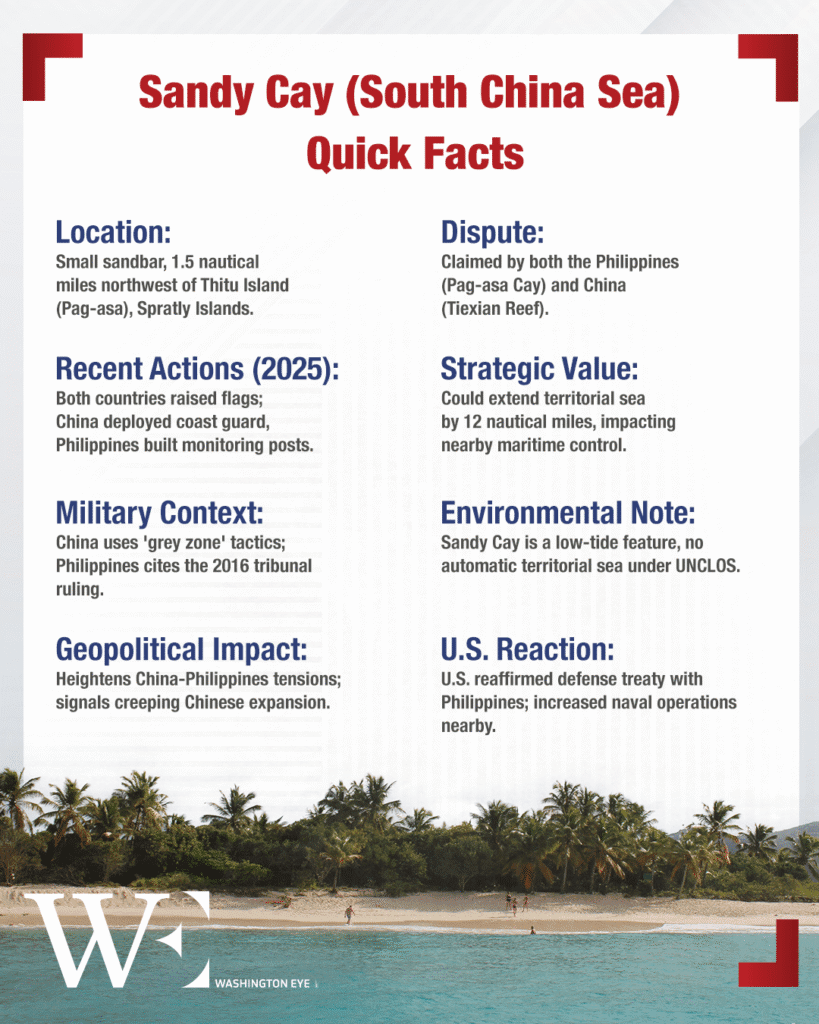The Chinese coast guard’s recent seizure of Sandy Cay (known in China as Tiexian Reef) represents not merely a symbolic assertion of sovereignty, but a deliberate escalation in the South China Sea dispute. Chinese coast guard personnel accused six Filipinos of “illegally boarding” the sandbank and responded by unfurling China’s national flag, performing an inspection, and collecting video evidence of what Beijing termed “illegal activities”.
Though small and uninhabited, Sandy Cay’s proximity to Thitu Island, a Philippine-controlled territory, imbues it with disproportionate strategic significance. Notably, there were no immediate signs that China had established permanent infrastructure on the sandbank. However, the political theater of planting a flag and “exercising jurisdiction” sends a potent message of creeping annexation.
Broader Strategic Context: Exercises and Escalation
This incident unfolds against a backdrop of increasing militarization in the region. Manila, in tandem with the United States, recently launched the “Balikatan” joint military exercises, a series of comprehensive drills featuring integrated air and missile defense simulations — a significant first. Beijing has derided these drills as destabilizing provocations. Nonetheless, the Philippines’ military presence on Thitu Island, bolstered by a coast guard monitoring station opened in 2023, underscores Manila’s resolve to resist Chinese encroachments.
China’s actions at Sandy Cay could therefore be interpreted as a counter-move — a bid to disrupt the growing U.S.-Philippines security cooperation that Beijing views as a direct threat to its strategic ambitions. Indeed, China’s state-run media covered the sandbank operation as an act of sovereign defense rather than aggression.
Legal and Diplomatic Implications
Despite the optics of control, China’s claim to Sandy Cay — as with much of the South China Sea — lacks international legal standing. The 2016 Permanent Court of Arbitration ruling in The Hague unequivocally invalidated China’s expansive “nine-dash line” claims. Nonetheless, Beijing continues to reject this decision, instead relying on coercive actions to create “facts on the ground” that later solidify into de facto control.
The Philippines’ options in response are limited but crucial. While direct military confrontation remains unlikely given the imbalance of forces, Manila will likely seek to leverage diplomatic pressure through ASEAN and reinforce its alliance with Washington. Yet, as seen in previous episodes, international protests often fail to reverse Chinese gains once a physical presence has been established.
The Broader Regional Chessboard
Sandy Cay is a microcosm of a wider strategic contest unfolding across Southeast Asia. Beyond territorial control, these confrontations are about setting precedents for behavior in international waters and about demonstrating resolve to domestic and international audiences alike. With nations like Vietnam, Malaysia, and Indonesia also wary of Chinese assertiveness, Beijing’s moves risk galvanizing a broader regional counter-coalition.
The timing of this latest seizure, amid live-fire exercises and amid environmental disputes between Beijing and Manila, signals that the South China Sea will remain a geopolitical flashpoint well into the future.
A Final Note
Sandy Cay highlights a critical turning point: China’s willingness to openly confront its neighbors in gray zones once considered too sensitive for unilateral action. By seizing even tiny features like Sandy Cay, Beijing signals that no claim is too small, no space too marginal, for strategic contestation. For the Philippines, the incident exposes the persistent challenge of defending scattered outposts against a much larger rival, emphasizing the urgent need for Manila to strengthen its maritime posture, deepen international partnerships, and assert its rights under international law before such encroachments become irreversible.
















